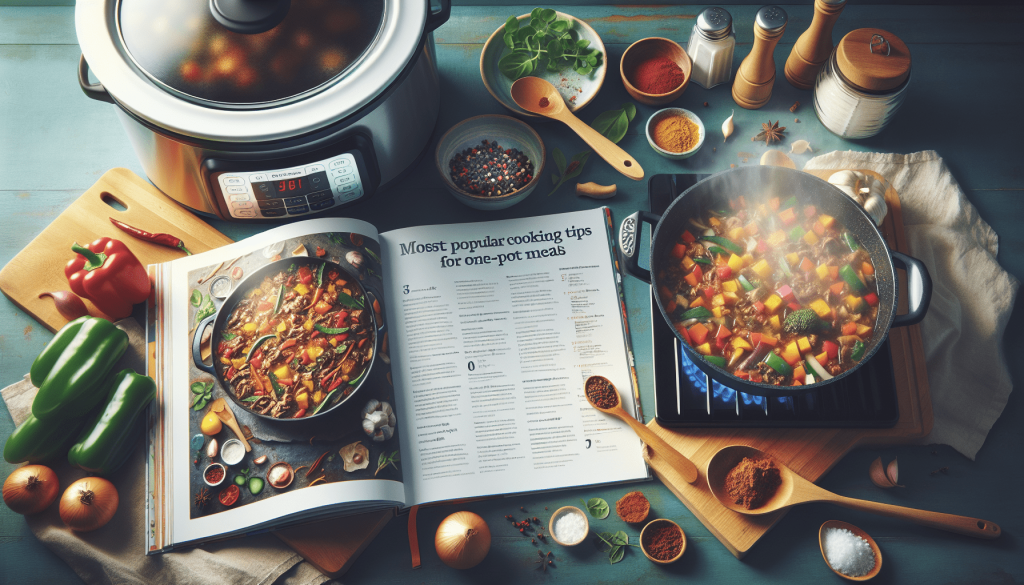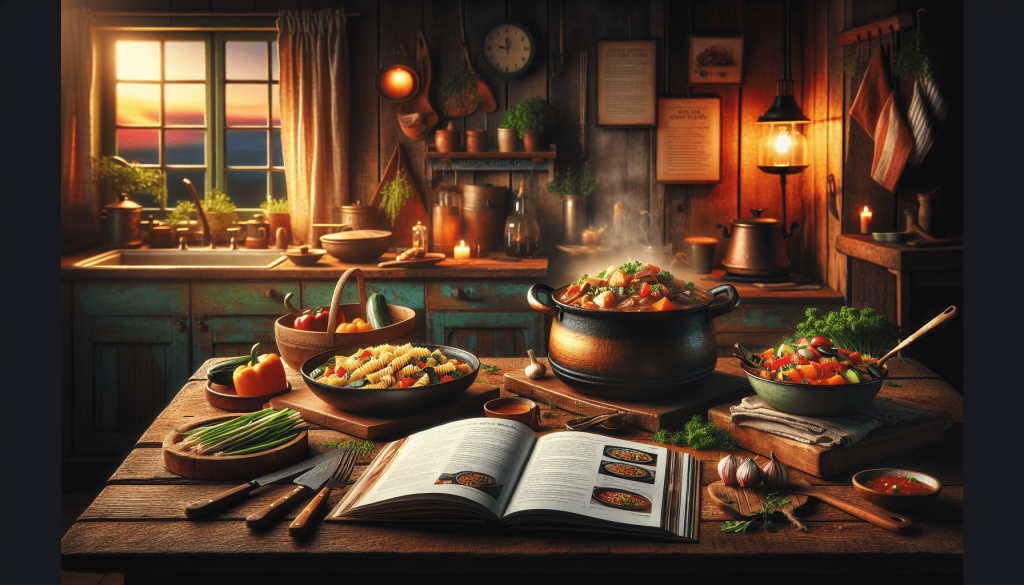You’re about to discover the most popular and practical cooking tips for creating delicious one-pot meals. Whether you’re short on time or just looking for an easy and flavourful dinner option, these tips will have you cooking up tasty dishes with minimal effort and maximum satisfaction. Get ready to master the art of one-pot cooking and impress your friends and family with your culinary skills!
Choose the right pot
When preparing one-pot meals, it’s important to choose the right pot that will accommodate all your ingredients and provide optimal cooking conditions. One factor to consider is the size of the pot. You want to ensure that there is enough space for all the ingredients to cook evenly without overcrowding the pot. It’s better to opt for a pot that is slightly larger than you think you might need, as this will prevent any potential spills and give you room to stir and mix ingredients comfortably.
Another aspect to consider when choosing a pot is the material it is made from. Different materials have different heat-conducting properties, which can affect the cooking process. For example, stainless steel and cast iron are excellent choices for conducting and retaining heat evenly, while non-stick pots may not distribute heat as well. Consider your cooking style and preferences when selecting a pot material to ensure the best results for your one-pot meals.
Lastly, it’s beneficial to choose a pot with a lid. Having a lid allows you to cover the pot while cooking, helping to retain heat, lock in flavors, and prevent excessive moisture loss. It also helps to create a moist and tender environment for your ingredients, resulting in a more delicious and flavorful dish.
Prep ingredients beforehand
Before diving into the actual cooking process, take some time to prepare all your ingredients. This will not only save you time during the cooking process but also ensure that everything is ready to go when you need it.
Start by chopping your vegetables. Depending on the recipe, you may need to dice, slice, or julienne your vegetables. By preparing them in advance, you’ll have them readily available to add to your one-pot meal as needed, without disrupting the cooking process.
Similarly, measure out your spices and herbs beforehand. This ensures that you have the correct quantities ready to go, avoiding any last-minute scrambling to find and measure ingredients while your dish is simmering away. Having pre-measured spices and herbs also allows you to adjust the flavors to your liking more easily.
If your recipe involves meat or poultry, consider marinating it ahead of time. Marinating meat not only adds flavor but also helps to tenderize it. By allowing your meat to marinate beforehand, you’ll be enhancing the taste and texture of your one-pot meal.

Layer ingredients strategically
When it comes to one-pot meals, the order in which you add your ingredients can make a significant difference in the overall outcome. Strategic layering ensures even cooking and allows delicate ingredients to remain intact.
Start by placing dense ingredients at the bottom of the pot. These ingredients, such as root vegetables or tough cuts of meat, require more time to cook and soften. Placing them at the bottom ensures they receive direct heat and cook thoroughly.
As you layer your ingredients, gradually add fragile ingredients towards the end. Delicate vegetables like peas or leafy greens have shorter cooking times, and by adding them later, you prevent them from becoming overcooked and mushy.
Consider the cooking times of your ingredients when layering. If you have ingredients that require different cooking times, such as potatoes and fish, you may want to add the ingredient that takes longer to cook first and then introduce the quicker-cooking ingredients later in the cooking process.
Use the right amount of liquid
The amount of liquid you add to your one-pot meal is crucial for achieving the desired consistency and preventing your dish from becoming too dry or soupy. Following the recipe guidelines for liquid measurements is always a good starting point, but there are other factors to consider as well.
The density of ingredients can affect the amount of liquid needed. Ingredients like rice or pasta absorb a significant amount of liquid while cooking, so you may need to add a bit more liquid to compensate for this absorption. On the other hand, if you’re cooking a recipe with high-water content ingredients like tomatoes or mushrooms, you may need to reduce the liquid amount slightly to prevent your dish from being too watery.
Additionally, consider evaporation when adding liquid. If your pot does not have a tight-fitting lid or if you’re simmering your dish uncovered, more liquid may evaporate during the cooking process. Keep an eye on the liquid levels and add more if necessary to maintain the desired consistency.

Seasoning and flavouring
To elevate the taste of your one-pot meal, it’s essential to season and flavor it appropriately. Salt and pepper are versatile seasonings that should be added at various stages of cooking to enhance the flavors of the dish. Remember to add these seasonings in moderation, tasting as you go, to avoid oversalting or overpowering the dish.
Incorporating spices and herbs can take your one-pot meal from ordinary to extraordinary. Whether you’re using dried spices or fresh herbs, they add depth and complexity to the flavors. You can experiment with different spice blends or herb combinations to suit your preferences. Don’t be afraid to get creative and try new flavor combinations to make each dish unique.
If you want to give your one-pot meal an extra boost of flavor, consider using stock or broth as part of your liquid base. Stock or broth infuses the dish with rich flavors and can complement the ingredients you’re cooking. Vegetable, chicken, or beef stock are common choices, but you can also consider using fish or mushroom stock for more specific flavor profiles.
Monitor the heat
Proper heat management is crucial when preparing one-pot meals. It’s essential to adjust the temperature as needed throughout the cooking process to ensure that your dish cooks evenly and doesn’t burn.
Start by preheating your pot over medium heat before adding any ingredients. This allows the pot to heat up evenly, ensuring that the food cooks uniformly. Once you’ve added your ingredients, you may need to increase or decrease the heat to maintain a simmer.
Avoid high heat that can lead to burning or scorching. One-pot meals are typically cooked over gentle heat for extended periods to allow the flavors to develop and the ingredients to cook through. Using low or medium heat ensures that the food cooks evenly without any unpleasant burnt flavors.
Maintaining a simmer is often the desired heat level for one-pot meals. A simmer is when the liquid is gently bubbling, but not boiling vigorously. This gentle heat allows for even cooking without excessive evaporation, resulting in a well-balanced dish.
Stir occasionally
Throughout the cooking process, it’s important to occasionally stir your one-pot meal. This has several benefits, including preventing ingredients from sticking to the bottom of the pot and ensuring even cooking.
By stirring the ingredients, you prevent them from settling and sticking to the bottom, which can lead to uneven cooking or burning. This is particularly important for recipes that require longer cooking times. Regular stirring helps distribute the heat evenly and prevents any ingredients from forming a crust on the bottom.
Stirring also helps combine flavors. As you mix the ingredients, the flavors meld together, creating a harmonious taste throughout the dish. It’s especially crucial when using spices or herbs, as stirring helps distribute their flavors more evenly.
Remember not to over-stir, as excessive stirring can cause delicate ingredients to break apart or become mushy. Aim to stir gently and occasionally, allowing the ingredients to cook and develop their flavors naturally.
Test for doneness
To ensure your one-pot meal is cooked to perfection, it’s important to test for doneness before declaring it ready to serve. There are several ways to determine whether your dish is cooked thoroughly.
Protein, such as meat or poultry, should be checked for texture. Use a meat thermometer to ensure that the internal temperature reaches the appropriate level for the specific type of protein you’re cooking. This ensures that your meat is not undercooked, which can be a food safety concern.
For vegetables, test their tenderness by piercing them with a fork or tasting a sample. Vegetables should be soft enough to be enjoyed easily but still retain some bite. Each vegetable may have a different ideal texture, so use your judgment and personal preference when determining the doneness.
Lastly, taste for seasoning. Sampling your one-pot meal allows you to adjust the salt, pepper, spices, or herbs if needed. If you find that it lacks flavor, you can add a little more seasoning to enhance the taste. Remember that it’s easier to add more seasoning gradually than to remove excess salt or spices once they have been added.
Let it rest
After your one-pot meal is cooked to perfection, it’s important to let it rest before serving. Allowing your dish to rest has several benefits and contributes to the overall taste and quality of the meal.
Giving your one-pot meal time to rest allows the flavors to meld together. The heat and steam trapped in the pot during the cooking process continue to infuse the ingredients and develop the flavor profile. This resting period allows the dish to achieve its full potential, resulting in a more flavorful and delicious meal.
Additionally, letting your one-pot meal cool slightly before serving prevents any potential burns. Hot dishes can cause accidental scalding if consumed immediately, so it’s best to allow them to cool down to a safe temperature for eating.
Consider the appropriate serving temperature for your dish. Some one-pot meals are best served piping hot, while others benefit from being served at a slightly warmer or cooler temperature. Take into account the type of ingredients and flavors in your dish and decide on the optimal temperature for the most enjoyable dining experience.
Experiment with variations
One-pot meals offer endless opportunities for experimentation. Once you’ve mastered the basics, don’t be afraid to try different ingredient combinations, explore international cuisines, and adapt recipes to your personal preferences.
Varying the ingredients can completely transform a one-pot meal. You can add or substitute different vegetables, proteins, or grains to create unique flavors and textures. Consider seasonal produce or local ingredients to make your dish more exciting and take advantage of what’s available.
Exploring international cuisines opens up a world of new flavors and cooking techniques. You can incorporate spices and herbs specific to different cuisines to create exciting and authentic one-pot meals. Don’t be afraid to try your hand at Thai curries, Mexican stews, or Italian risottos, among many other options.
Feel free to adapt recipes to suit your personal preferences. If a recipe calls for ingredients you don’t enjoy, you can easily substitute them with ones you prefer. You can also adjust the spice levels, saltiness, or sweetness to cater to your own taste buds. One-pot meals are versatile, so make them your own and let your creativity shine.
By following these tips for preparing one-pot meals, you’ll be well on your way to creating delicious and satisfying dishes. Remember to choose the right pot, prep your ingredients beforehand, layer strategically, use the appropriate amount of liquid, season to perfection, monitor the heat, stir occasionally, test for doneness, let it rest, and don’t be afraid to experiment with variations. Enjoy your culinary journey and savor the wonderful flavors that one-pot meals have to offer.
